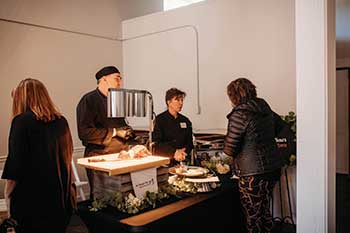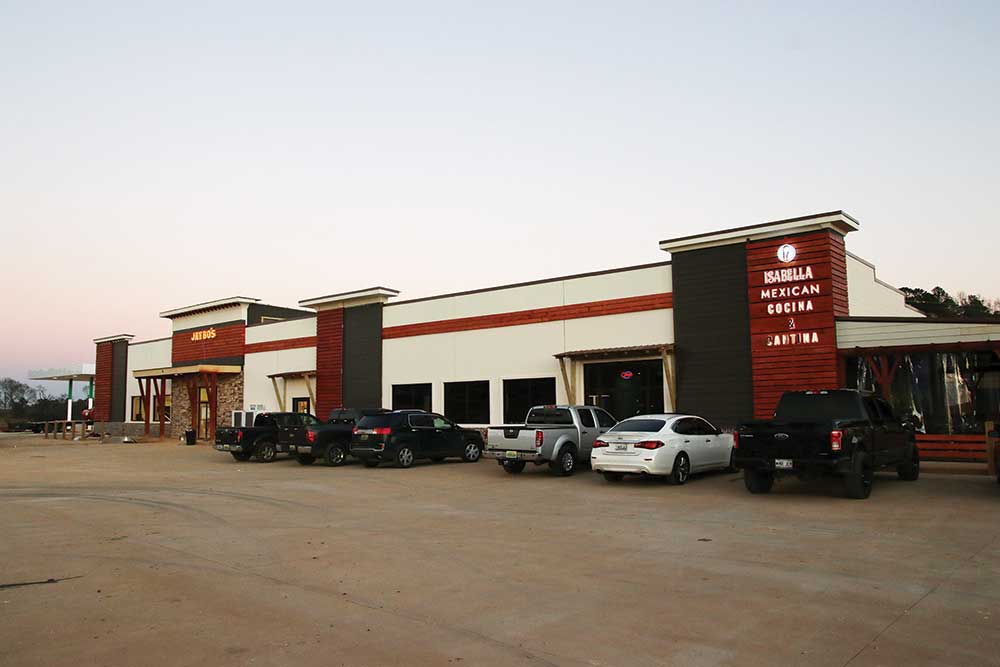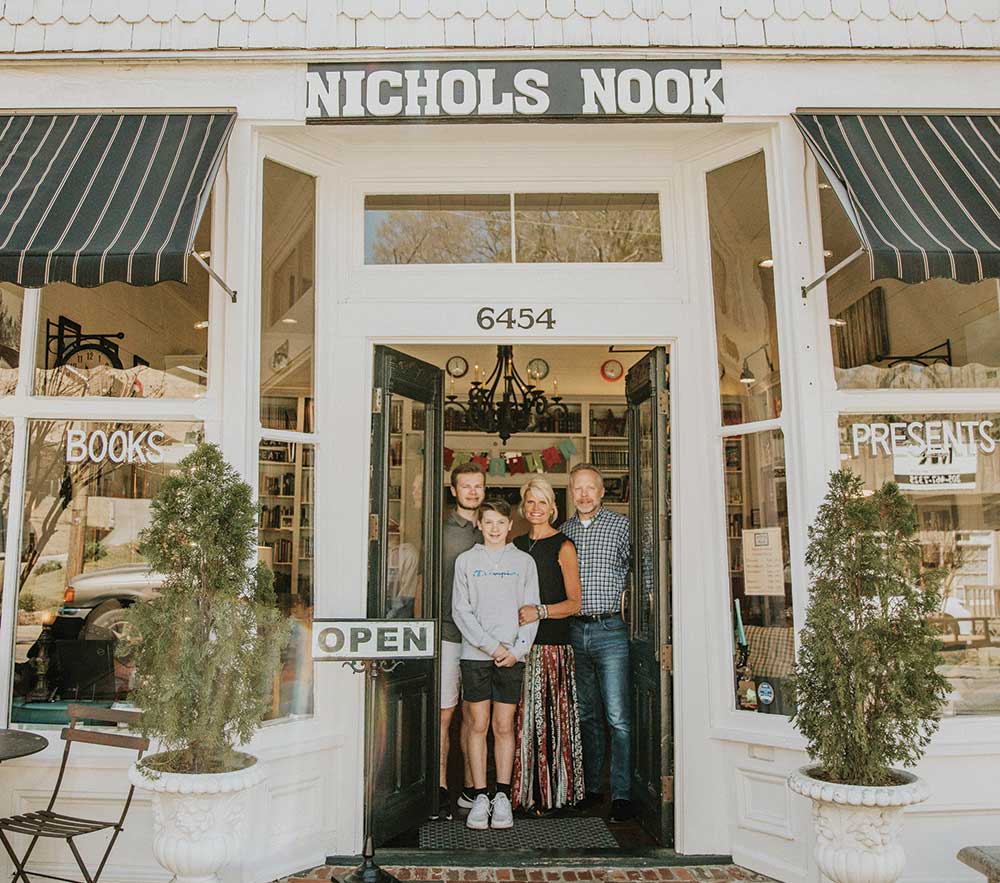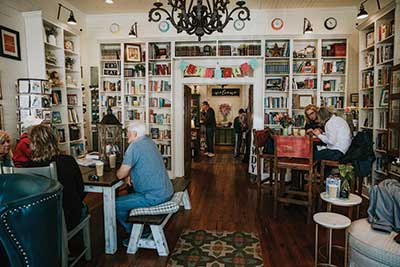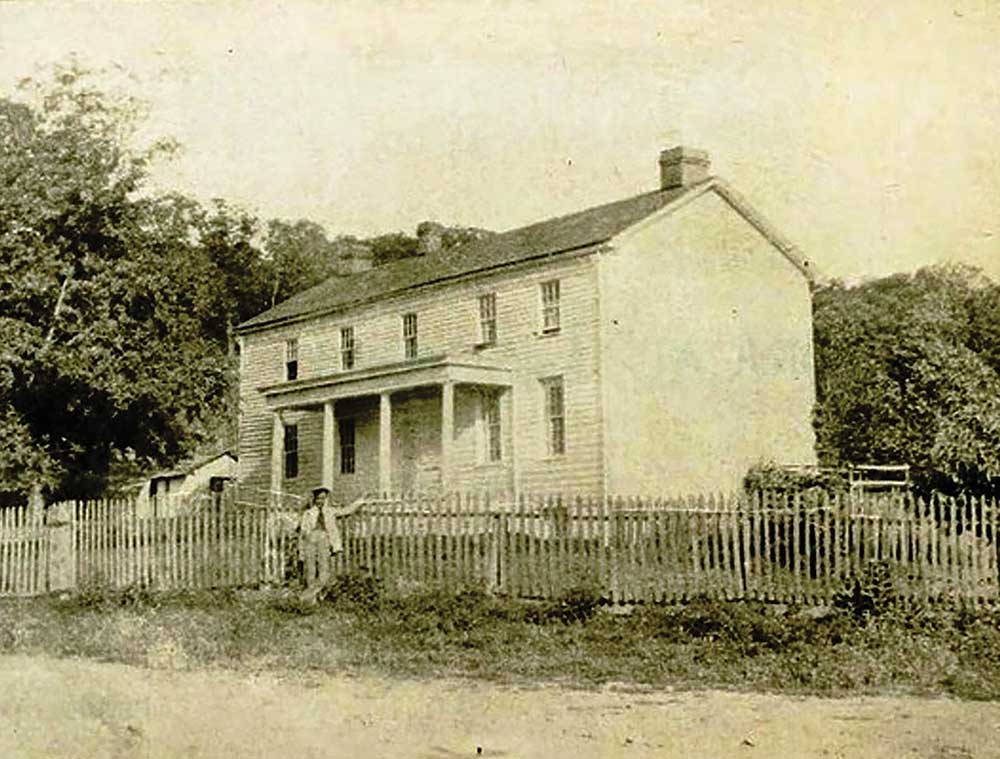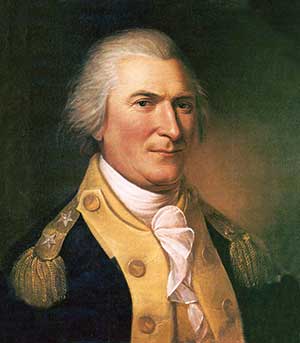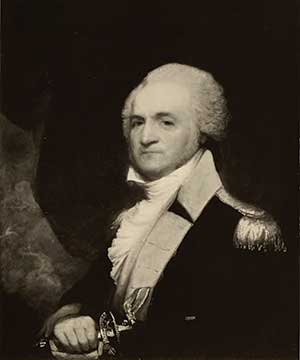Bridal show has it all for the big day
Story by Elaine Hobson Miller
Photos by Meghan Frondorf
Outdoor weddings, full meals instead of receptions and the Bohemian look are gaining popularity among today’s brides. So are body waxing, boudoir books, naked cakes and walking down the aisle to music other than the traditional, “Wedding March.” One of the biggest surprises, however, is how the COVID-19 pandemic may have worked in their favor.
“For thepast two years, brides went through postponements and reschedulings, but the benefit from this is that they saved more money up and so have had more to spend on their weddings,” says Amanda Robbins of AMR Bridal & Events. “Now they can afford add-ons like a vintage car for the getaway, a DJ or more lavish tablescapes at the reception.”
AMR was part of the second annual Bridal Show at Springville’s Woodall Building in March. Twenty-one vendors participated, from planners like Robbins to florists and caterers, singers, photographers and travel agents.
“It’s important to hire a planner because of the amount of stress it takes off the bride and her family,” says Robbins, who is in partnership with her husband, Jordan. “There are lots of planners out there. The goal is to find one who sees your vision best and that you can connect with.”
Most planners have packages that fit a wedding couple’s budget and needs, because one size doesn’t fit all. “I meet them where they are in their planning and lead and guide them from there,” says Robbins.
Some people want it all handled for them, while others just want “day of event” planning, according to Dee Wilson of Oh La La in Trussville. “In this area (St. Clair County), wedding budgets usually run from $5,000 to $20,000,” Wilson says. “Brides will allot so much to catering, photography, flowers, etc. I like to see them take that $20,000 they’ve budgeted, use $8,000-$10,000 for the wedding and the rest to pay off a student loan or to put down on a house.”
For the past 5-10 years, brides have been serving full meals more than the simple cake-and-mint receptions. Wilson says it’s cheaper to do a meal than hors d’oeuvres because the latter can mean a lot of pieces per person — usually about seven. “Alcohol is huge now,” she says. “Girls want more of a party, and when you offer free alcohol for four hours, people will party!”
Before the big day
Pre-wedding skincare and skincare parties are trendy with today’s brides, too.
Firming creams to lift faces and tighten thighs can be used in the comfort of one’s own home, says Katelyn Lear, who partners with Pure Romance, a company that specializes in women’s wellness. Lear sells bath and body products, lacy negligees and intimate products.
“One of our skin-firming creams works in 24-48 hours and one in two hours,” she says. “Lots of people are still using self-tanners, which are safer than tanning beds. If you don’t like the results, it (the tan) will fade in 72 hours. We also host bachelorette and lingerie parties.”
Springville’s Beauty Society specializes in clinical-grade skincare. Usage should start at least two-three months before the wedding, according to Ceil McDanal. “Our products are designed for skin repair, not just a quick fix,” she says. “Every person would have a different regimen, depending on their skin type.”
Nadia Johnson says another trend is body waxing for brides-to-be. “With waxing, you don’t have to worry about any body hair throughout the wedding or honeymoon,” she says. “It lasts three to four weeks.” Gaining popularity is the waxing party, where the bride and bridesmaids get together over drinks and have a portion of their bodies waxed. Some choose brows and facial hair, others their necks, legs, underarms or the Brazilian (bikini) wax. “Underarms and legs are really popular during the summer,” says Johnson, an esthetician at Isabella Anya Body Waxing Studioin Springville.
Glow Getters of Trussville also handles spray tans for a bride’s wedding day, bachelorette trips and the honeymoon. The company helps brides host bridal spray-tan parties, too. “People pay individually, and when four or more people buy a spray tan, the bride-to-be gets hers for free,” says owner Ashley Ritch.
Tabitha Austin of Steele is a hairstylist who does hair and makeup for weddings under the name of Beauty by Tab. She says today’s trend is toward a natural, glowy look for the bridal party’s makeup, along with thicker eyebrows. “I use a gel for the brows, because it’s a little easier than powder,” Austin says. As for hair trends, she says the Boho (Bohemian) look is in for brides and bridesmaids, where their hair is part up, part down and has lot of braids.
If a bride and her family don’t want to address dozens of invitations, they can hire Mrs. Scribbles Calligraphy. Kim Kimbrough uses calligraphy, a decorative form of handwriting, to address invitations to weddings, parties and bridesmaids’ luncheons, save-the-date notices and table cards. “I started doing calligraphy in high school and used it to address my own wedding invitations 30 years ago,” Kimbrough says. While the style is more popular now than then, today’s bride usually prefers a more modern script to the Old English font of yore.
Capturing the memories
When a bride is ready to line up a photographer to capture those precious wedding moments, the trend is to record and preserve everything from the proposal to the honeymoon, although not necessarily in that order.
“Lots of brides are looking for highlight trailers, which are photos or scenes that aren’t in chronological order,” says Crystal Gray of Gray Manor Creatives of Birmingham. “We might feature the reception first, then the vows, everything out of order,” she says. Her setup includes drones and creative angles that allow couples the chance “to experience their wedding day in a true, unexpected, cinematic way.”
One of the extensions to the basic bridal photo package is the bridal boudoir book. It contains more intimate photos of the bride for the husband. “We have an app available where they can download the photos and send them directly to him, or we’ll print a hardback photo album that she can give him as a wedding gift to be opened after the wedding, like when he’s getting dressed,” Gray explains.
Boudoir books aren’t something Soulgrown Photography’s Mandy Smith and Kimberly Gaddis wanted to get into. “But people started asking for them. They are very popular,” says Smith. Today’s bride wants “full-day coverage, not just the wedding and reception,” she says. “People are spending more on photography because they want more.”
Modern bridal parties want most of the formal photos done before the wedding so they can enjoy friends and family at the reception. “No more receiving lines,” Smith says. She and Gaddis strongly suggest an “unplugged” ceremony so the cellphones of friends and family taking photos don’t interfere with the professional efforts.
Makenzie Neely, the photographer behind Neely Creative, ofSteele, says it’s trendy to have adventure elopements where the bridal couple escapes to the mountains or seashore by themselves or with close family. “They’ll pick a destination local or away and ask us to photograph the event,” she says. “The farthest we’ve been is Crested Butte, Colo. It was for a Springville couple, and the wildflowers there were beautiful.”
Neely offers hardcover books and print albums, but most couples just print what they like and save the rest on their computer. “I give the pictures to them digitally,” she says. “Most of my galleries are 800-1,000 pics for an eight-hour day.” Some people still do film, but it’s an unnecessary added expense, she says.
The music
When it comes time to select the music for their special day, modern brides don’t always walk down the aisle to the traditional “Wedding March” by Felix Mendelssohn. Often, it’s to “Canon in D” by Johann Pachelbel or Johann Sebastian Bach’s “Jesu Joy of Man’s Desiring.” Just as often it’s to a particular piece of music that is special to the bride and bridegroom, according to three area music providers.
“One couple wanted music by a South Korean pianist named Yiruma, particularly, ‘Kiss the Rain,’” says Kara Lancaster of Kara Pure Music Studio. “Some of his songs sound like raindrops falling.” They also wanted a jazz version of “Somewhere Over the Rainbow” during the ceremony. Lancaster, a pianist and vocalist, says wedding parties are walking out to more upbeat songs after the ceremony, too, such as Etta James’ “At Last.”
Rita Allen, who provides vocals over soundtracks for weddings and receptions, says selecting the music usually is a joint effort between the bride and the bridegroom. “A lot of them blend the traditional with the modern,” she says.
Allen, who can sing anything from opera to bluegrass in English, French or Italian, bought the old Murray’s Chapel Church of God building on U.S. Highway 11 in Springville and renamed it Allen Hall. It is now a concert hall, music teaching studio, tea room and event venue.
Lee Jeffrey, a Springville disc jockey who goes by DJ Lee L, sees a trend toward fall weddings. “Summer used to be more popular, but the weather is so blazing hot in summer,” he says. He, too, tailors the music he plays to fit the bride’s wishes, and sees more people foregoing the “Wedding March” in favor of pieces like “Canon in D.”
“They just got tired of the ‘Wedding March,’ I guess,” he says.
The flowers
Flower arrangements are featuring blushes and creams or simply ivory and greenery, with a touch of blue and maybe a dash of something whimsical, according to two area floral designers.
“A touch of whimsy, like pampas grass in arches and centerpieces, is popular these days,” says Hannah Steele of Steele Magnolias in Springville. “Peonies and dahlias are our biggest sellers. However, dahlias are for cooler weather because they wither in the heat.” Taylor, a home-based floral designer, says blue is a popular color used in many weddings now, such as white anemones with blue centers. “Tulips are suddenly being requested, too,” she says.
Simply Sage Florals, inthe Moody-Trussville area, arranges a lot of ivory and greenery at weddings, according to co-owner Tina Locke. “We use a lot of delphiniums with ivory garden roses, for example,” Locke says. “We’ll use them in the bridal bouquet, all the bridal party arrangements and the tables at the reception.” As an alternative to flowers, cylindrical candles and votives are cost-effective and popular. “Some venues won’t allow candles, so we’ll use battery-powered ones,” Locke says. “We might use bridesmaid bouquets as centerpieces on individual tables.”
The menu
Five to 10 years ago brides wanted finger foods at their receptions. Today, the biggest food trend is the taco-and-fajita bar, according to Sonya Bates of Our Family to Yours Catering and Events in Springville. “Another trend is stations,” she says. “They might have a ‘mashed-tini’ bar consisting of mashed potatoes in martini glasses with toppings, a macaroni-and-cheese station and a carving station.” Barbecue is always a safe bet at receptions, along with smoked ham, pork, brisket or ribeye at carving stations. Buffets are popular, too. Her brother and partner, Richard Harper, handles the meat side of the business. “Banana and blueberry shooters are popular desserts, usually at the bridegroom’s table,” she says.
Morgan Yundof The Flying Biscuit Cafein Birmingham says people are scheduling more daytime weddings, even as early as 9 a.m. “Then they’re going into brunch afterward,” she says. “Venues tend to be cheaper during the day.” She says weekdays are becoming popular and so are outdoor weddings. “People are getting creative because of their budgets,” she says. She and her husband, Greg, specialize in breakfast and lunch and are known for their biscuits and grits. “Lunch can be shrimp and grits or chicken and waffles, and they can be for breakfast and bridal teas, too.”
What’s for dessert?
What would a wedding reception be without a cake? It might just feature shaped cookies with messages or naked cakes, because both are gaining in popularity among brides and bridegrooms who don’t like a lot of gooey frosting.
“One woman did cookies instead of a cake at her reception because she didn’t like the traditional wedding cake,” says Michelle Green,owner of Sweet Pea’s Cookie Creations in Springville. She makes shaped cookies and decorates them with figures or messages. The latter are popular for teas, showers and receptions and are sometimes used as favors at wedding dinners. She once made boxes of cookies that said, “Will you be my bridesmaid?”
As for that “naked cake,” it has some icing, but most of it is on top, and there is far less decorating involved, according to Anissia Howard, owner of A Piece of Cake in Odenville. “It’s still a traditional three-tiered wedding cake with almond flavoring, though,” she says.
When her own daughter got married last December, mom made a three-tiered cake with whipped-cream icing and decorated it with greenery because daughter doesn’t like sweets. “More brides are ordering cupcakes instead of tiered cakes, and the groom’s side wants cookie and brownie trays instead of a groom’s cake,” she says.
The honeymoon
After they’re stuffed with dinner and cake and drive away in their rented stretch limousine, most brides want to fly off to Jamaica, the Dominican Republic, Mexico, Costa Rica or Saint Lucia, according to two area travel agencies. They much prefer all-inclusive resorts to cruises and adventures.
“Most people have an idea of where they want to go,” says Ashley Ritch of Ritch Travels in Trussville. “Usually the bride selects the destination, and they’ll choose a resort over a cruise. Resorts are letting up on their COVID vaccination restrictions, but cruise ships still require vaccinations.”
Kathy Richards, of Ash Travel in Springville, says all-inclusive packages are the most popular for honeymooners. “All-inclusive means room, food, beverages and tips, and when I book, I include airfare and transfers to and from the hotel. I can book excursions, too.”
Honeymooners don’t go sight-seeing per se, but they do like ziplines, snorkeling, rafting or riding a dune buggy around an island. “People don’t book cruises much because they’re too crowded, and there’s not much privacy for a honeymoon, whereas resorts have nooks and crannies for privacy,” she says.
A big trend at these island resorts is toward the oceanfront, on-the-beach suite where you can swim right up to your room’s door or step out onto the balcony and into a pool. “Suites that have butlers and private pools for just your room are popular, because honeymooners want lots of room service, especially at breakfast,” Richards says. “They stay up late drinking and don’t want to get up early.”
The Ring
Central to the wedding ceremony is the ring, and there are plenty of new options to go along with the more traditional.
Gaining popularity because of its beauty and its price are Lab Grown diamonds, according to Michael Abernathy, vice president of sales and marketing at Griffins Jewelers. They are identical to earth-mined diamonds in every way, except that they are grown in a laboratory above ground.
They have the same chemical, physical and optical properties as mined diamonds and exhibit the same fire, scintillation and sparkle, he said.
“We offer lab-grown diamonds as an alternative choice for our customers. All lab-grown diamonds we sell are laser inscribed ‘LAB GROWN’ on the girdle,” he noted.
Griffins offers both mined and lab-grown diamonds. “We want our customers to know about all options available and to choose what is best for their budget and desires,” Abernathy said. “Lab-grown diamonds allow our customers the opportunity to choose a high-quality diamond at a much lower price point.”
For the groom, some are returning to white and yellow gold traditions, but alternative metals are still extremely popular. A new trend is Tantalum, a rare earth metal that is used in rocket engines, missile guidance systems, electronics and medical implants.
It has a cool dark gray modern color and is listed on the periodic table as Ta. It can be plain or have a textured design.
“These rings are extremely durable, hypoallergenic and will never corrode or tarnish,” Abernathy said. “We can create any style of jewelry you desire. Every piece of jewelry has a story. We want your story to begin with us.”













